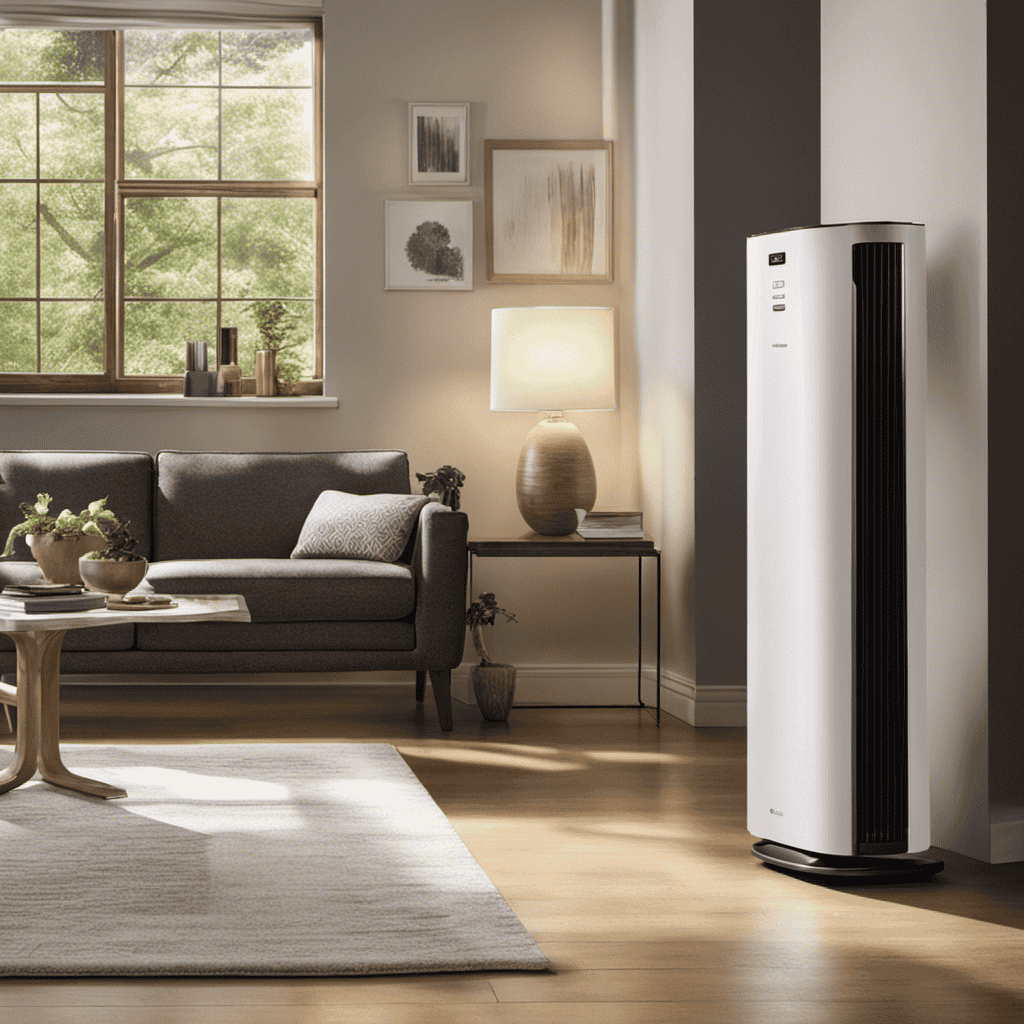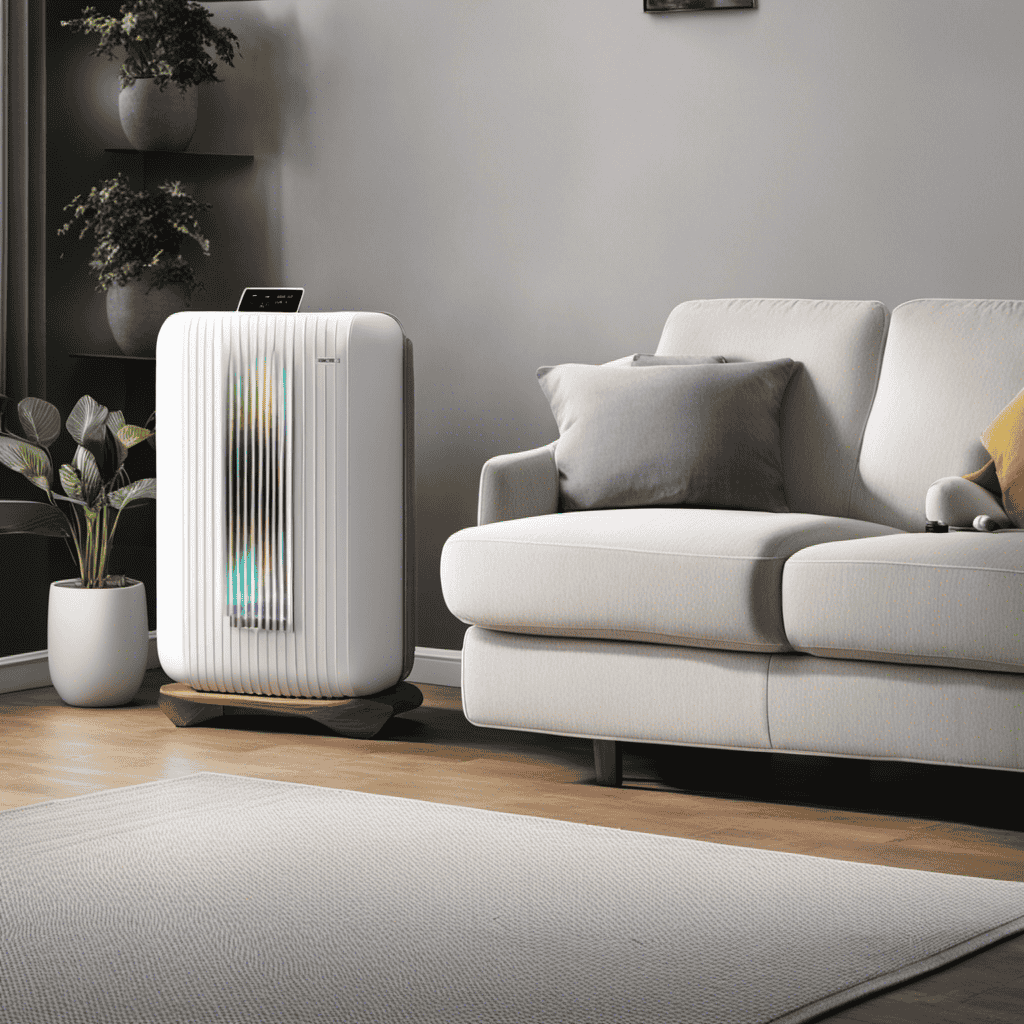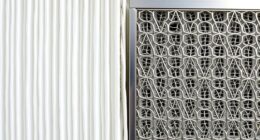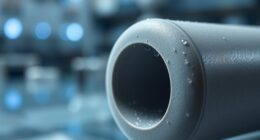As a proud owner of an air purifier, I understand the annoyance that comes with a malfunctioning device. It can feel like losing a reliable partner out of the blue. However, fret not! This article will explore the typical reasons behind air purifier malfunctions and offer helpful tips to troubleshoot and restore your unit back to working order.
We’ll explore the signs of a faulty air purifier and guide you through fixing electrical issues or addressing filter problems. Don’t let a non-working air purifier dampen your air quality – let’s fix it together!
Key Takeaways
- Clogged filters can restrict airflow and reduce the effectiveness of an air purifier. It is important to regularly clean or replace dirty filters.
- Power supply issues, such as loose or disconnected cords, can cause a non-functioning air purifier. Ensure that power cords are securely plugged in and check for any damage or fraying.
- Malfunctioning fan motors can hinder airflow and effectiveness. If the air purifier is not working properly, it may be necessary to contact a professional for motor repairs.
- Testing the power outlet with another device or resetting the circuit breaker can help determine if the issue is with the power supply. If the outlet is not providing power, it may be necessary to contact an electrician.
Common Causes for Air Purifier Malfunction
One common reason why your air purifier isn’t working could be a clogged filter. When the air filter gets clogged with dust, pet dander, and other pollutants, it restricts the airflow and reduces the effectiveness of the purifier. To troubleshoot this issue, start by checking the filter. Remove it from the unit and inspect it for any visible dirt or debris. If it appears dirty, it’s time to clean or replace it. Cleaning the filter is usually straightforward and involves rinsing it under running water or vacuuming it to remove the trapped particles. However, some filters may require replacement, especially if they are not washable.
Aside from a clogged filter, there are other common air purifier problems that you may encounter. One of them is a malfunctioning fan. If the fan is not spinning or making unusual noises, it can hinder the airflow and reduce the effectiveness of the purifier. In this case, you can try resetting the unit or contacting the manufacturer for further assistance.
Another potential issue is a faulty sensor. Air purifiers often come with sensors that detect the air quality and adjust the purification settings accordingly. If the sensor is not functioning properly, it may not accurately detect the pollutants in the air or control the fan speed. To troubleshoot this problem, refer to the user manual for instructions on recalibrating or replacing the sensor.
Troubleshooting Tips for a Non-Functioning Air Purifier
When troubleshooting a non-functioning air purifier, there are several key points to consider.
First, check for any power supply issues, such as a loose or disconnected power cord.
Second, clogged filters can often cause obstruction and hinder the purifier’s performance.
Lastly, a malfunctioning fan motor can also lead to the air purifier not working properly.
Power Supply Issues
The first thing you should check is if your air purifier isn’t working due to a power supply issue. Troubleshooting power issues is crucial to determine the root cause of the problem.
Start by checking the power cords. Ensure that they are securely plugged into both the air purifier and the power outlet. Look for any signs of damage or fraying on the cords. If you find any, it’s important to replace them immediately.
Additionally, make sure that the power outlet is functioning properly by plugging in another device. If the outlet is not providing power, you may need to reset the circuit breaker or contact an electrician.
Clogged Filters Causing Obstruction
To fix the clogged filters causing obstruction, you should remove and clean them regularly to ensure proper airflow.
When the filters in an air purifier become clogged with dust and debris, it can significantly reduce the unit’s effectiveness in removing airborne particles.
To troubleshoot this issue, begin by turning off and unplugging the air purifier. Carefully remove the front grille or cover to access the filters.
Take out the filters and inspect them for dirt and debris buildup. If the filters are dirty, gently clean them according to the manufacturer’s instructions.
Once the filters are clean and dry, reinsert them back into the air purifier and replace the front grille or cover.
Regular filter maintenance, including periodic replacement, is essential for optimal performance and to ensure that your air purifier continues to work effectively.
Malfunctioning Fan Motor
If the fan motor is malfunctioning, you should contact a professional for repairs. Troubleshooting techniques can help identify the problem, but attempting to repair the motor yourself can be dangerous and may cause further damage.
Here are three common issues that can arise with a malfunctioning fan motor:
-
Lack of power: Check if the motor is receiving electricity by ensuring the power cord is properly connected and the circuit breaker is not tripped.
-
Overheating: Excessive heat can cause the motor to malfunction. Clean any dust or debris from the motor and ensure proper ventilation around the unit.
-
Mechanical failure: If the motor is making strange noises or not spinning at all, it may be due to worn-out bearings or a faulty capacitor. These components should be replaced by a professional for proper fan motor repair.
Signs That Your Air Purifier Is Not Working Properly
One way to tell if your air purifier isn’t working properly is if it’s making strange noises. When your air purifier is functioning correctly, it should operate quietly, with minimal noise. If you notice any unusual sounds coming from your air purifier, it could indicate a problem that needs to be addressed.
To troubleshoot the issue and ensure proper air purifier maintenance, there are a few steps you can take.
First, check if there are any loose or damaged parts. Inspect the filters, fan, and other components for any signs of wear or damage. Clean or replace any dirty or clogged filters, as this can affect the performance of the air purifier. Additionally, make sure that the air purifier is properly connected to a power source and that the power cord is not damaged.
If these troubleshooting steps do not resolve the issue, it may be necessary to address electrical issues with your air purifier. Electrical problems can cause the air purifier to malfunction or make strange noises. In the next section, we will explore how to fix electrical issues with your air purifier and ensure its proper functioning.
How to Fix Electrical Issues With Your Air Purifier
When it comes to electrical issues with your air purifier, there are three key points to consider:
-
Power source problems: These can occur if the unit is not properly connected to an outlet or if there is a problem with the electrical supply.
-
Faulty wiring solutions: These may be necessary if there are loose or damaged wires within the air purifier.
-
Resetting the device: This can often resolve minor electrical issues and restore proper functionality.
Power Source Problems
Check if your air purifier’s power cord is securely plugged into the outlet. Power cord issues can often be the culprit behind a malfunctioning air purifier. Here are three common power cord issues to consider:
-
Loose connection: Ensure that the power cord is tightly plugged into the outlet and the air purifier. A loose connection can prevent the device from receiving adequate power.
-
Damaged cord: Inspect the power cord for any signs of damage, such as frayed wires or exposed insulation. A damaged cord can disrupt the flow of electricity and cause the air purifier to malfunction.
-
Voltage fluctuations: Fluctuations in voltage can damage the power cord and affect the air purifier’s performance. Consider using a voltage stabilizer or surge protector to protect your device from voltage irregularities.
Faulty Wiring Solutions
By inspecting the power cord for any signs of damage, you can easily address faulty wiring issues with your air purifier. Wiring troubleshooting is an essential part of electrical maintenance for any electronic device.
To begin, unplug the air purifier from the power source. Carefully examine the power cord, checking for frayed or exposed wires. If you notice any damage, it is crucial to replace the cord immediately to prevent electrical hazards. Additionally, ensure that the cord is securely connected to both the air purifier and the power outlet.
Avoid using extension cords or power strips, as they may not provide a stable electrical connection. By taking these steps, you can resolve any wiring issues and ensure the safe and proper functioning of your air purifier.
Now, let’s move on to resetting the device.
Resetting the Device
To reset the device, simply locate the reset button on the air purifier and press it for a few seconds. This is a common solution to many air purifier issues.
Here are three common problems that can be resolved by resetting the device:
-
Power failure: Sometimes, power fluctuations or outages can cause the air purifier to stop working. By resetting the device, you can restore power and get it up and running again.
-
Filter replacement: If the air purifier is not working efficiently, it might be due to a clogged or dirty filter. Resetting the device can help you reset the filter indicator and ensure that the purifier is working optimally.
-
Sensor malfunction: Some air purifiers have sensors that detect air quality. If these sensors are not functioning properly, resetting the device can recalibrate them and improve their accuracy.
Cleaning and Maintenance Tips for a Non-Operational Air Purifier
Make sure you’re regularly cleaning the filters and checking for any obstructions in your air purifier to ensure optimal functionality. Proper cleaning and maintenance are essential for the smooth operation of your air purifier. If you’re experiencing issues with your device, troubleshooting techniques and DIY repairs can often resolve the problem without the need for professional assistance.
The first step in troubleshooting your air purifier is to check the filters. Over time, the filters can become clogged with dust, dirt, and other particles, reducing the unit’s effectiveness. Remove the filters according to the manufacturer’s instructions and clean them thoroughly. Be sure to replace any worn or damaged filters.
Next, inspect the air purifier for any obstructions. Check the air intake and exhaust vents for blockages, such as dust or debris. Use a soft brush or cloth to gently remove any buildup. Additionally, ensure that the unit is placed in a location where there is sufficient airflow around it.
If cleaning the filters and removing obstructions doesn’t resolve the issue, you can try resetting the device. Refer to the user manual for instructions on how to perform a reset. This can often restore the air purifier to its default settings and resolve minor glitches.
Understanding Filter Problems in Your Air Purifier
Understanding how filter problems can impact the performance of your air purifier is essential. Filters play a crucial role in trapping pollutants and improving indoor air quality. However, they can encounter issues that affect their functionality.
Here are three common filter problems and troubleshooting techniques to address them:
-
Clogged Filters: Over time, filters can become clogged with dust, pet dander, and other airborne particles. This can restrict airflow and reduce the purifier’s efficiency. To troubleshoot this issue, try cleaning or replacing the filter according to the manufacturer’s instructions.
-
Filter Leaks: Sometimes, filters may not fit properly or have gaps, allowing unfiltered air to bypass the purification process. Check for any leaks or gaps in the filter housing and ensure a secure fit. If necessary, replace the filter with a new one that fits properly.
-
Filter Lifespan: Filters have a limited lifespan and need to be replaced periodically. If your air purifier is not working as effectively as before, it could be due to an expired filter. Refer to the manufacturer’s guidelines to determine the recommended filter replacement schedule.
Understanding these common filter problems and troubleshooting techniques can help you maintain the performance of your air purifier. However, if the issues persist or you are unsure about how to fix them, it may be time to seek professional help for a faulty air purifier.
When to Seek Professional Help for a Faulty Air Purifier
If the issues persist or you’re unsure how to fix them, it might be time to consider professional help for a faulty air purifier. While troubleshooting techniques can often resolve common problems, there are certain signs of air purifier malfunction that indicate the need for expert assistance. Here are some indicators that your air purifier may require professional attention:
| Sign of Malfunction | Possible Cause | Solution |
|---|---|---|
| Noisy Operation | Fan Motor Issue | Replace the fan motor |
| Weak Airflow | Clogged Filters | Clean or replace filters |
| Strange Odors | Mold or Bacteria | Deep clean or replace filters |
| Error Codes | Electronic Issue | Seek professional repair |
If you’re experiencing any of these issues, it’s best to consult a professional technician who specializes in air purifier repair. They have the knowledge and expertise to diagnose the problem accurately and provide the necessary solutions. Attempting to fix complex issues without proper training may lead to further damage or even render the air purifier irreparable. Remember, safety should always be a priority when dealing with electrical appliances. So, don’t hesitate to seek professional help if you’re unsure or unable to fix the problems with your air purifier.
Frequently Asked Questions
Can an Air Purifier Malfunction if It Is Not Used Frequently?
An air purifier can malfunction even if it’s not used frequently. Proper air purifier maintenance is essential to ensure its efficient functioning.
Neglecting regular maintenance tasks such as cleaning and replacing filters can lead to common air purifier problems. Dust and debris accumulation can obstruct airflow, reducing the purifier’s effectiveness.
Additionally, a lack of use may cause the internal components to gather dust and become clogged, impacting its performance. Therefore, regular maintenance is crucial to prevent malfunctions and ensure optimal air purification.
Why Does My Air Purifier Make a Strange Noise When It Is Turned On?
When my air purifier makes a strange noise upon turning on, it can be due to various reasons that require proper troubleshooting.
First, I check if the air purifier needs maintenance, such as cleaning or replacing filters.
If the noise persists, I inspect the fan motor for any obstructions or signs of damage.
Additionally, I ensure that the air purifier is placed on a stable surface to prevent vibrations.
These steps can help resolve the issue and improve the air purifier’s performance.
Can a Power Surge Cause My Air Purifier to Stop Working?
Yes, a power surge can cause damage to your air purifier and make it stop working. When a power surge occurs, it can overload the electrical components of the air purifier, resulting in malfunctions or complete failure.
To troubleshoot the issue, check if the power cord is securely plugged in and if the outlet is functioning properly. If the problem persists, it may require professional repair or replacement.
How Often Should I Replace the Filters in My Air Purifier?
When it comes to maintaining your air purifier, it’s essential to know how often to replace the filters.
Regularly cleaning the exterior of your air purifier is also important for optimal performance.
Signs that your air purifier filters need replacing include reduced airflow and a decrease in overall air quality.
Can Pets or Cigarette Smoke Affect the Performance of an Air Purifier?
Pets and cigarette smoke can indeed affect the performance of an air purifier. These common issues can lead to clogged filters and decreased air flow, resulting in reduced effectiveness. Regular air purifier maintenance is crucial to prevent these problems.
It is important to clean or replace filters as recommended by the manufacturer, especially if you have pets or smoke indoors. By properly maintaining your air purifier, you can ensure optimal performance and clean air in your home.
Conclusion
In conclusion, troubleshooting and fixing a non-working air purifier can be a daunting task. However, with a little effort and some basic knowledge, you can get your air purifier up and running again.
Just like a car that needs regular maintenance to perform at its best, an air purifier also requires proper care and attention. Remember, neglecting the maintenance of your air purifier can lead to poor air quality and health issues.
So, don’t wait until it’s too late to address the problem. Take action now and ensure that your air purifier is functioning optimally for a clean and healthy living environment.










